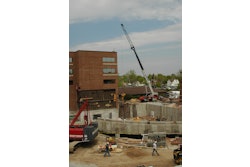
By Reed Erickson, M.D., MedExpress
There is no one-size-fits-all approach to returning to work in the wake of COVID-19, and each industry and workspace may require different procedures and protocols. In this article, we’ll look at Occupational Health and Safety Administration (OSHA) and Centers for Disease Control (CDC) recommendations to help keep construction workforces productive and healthy while implementing increased safety measures. While these guidelines are based on federal standards, it’s important to reference state resources frequently, as well, to make sure that all operations are in compliance.
Construction sites can present an interesting array of considerations for employers. What are some ways to limit employee interaction on a jobsite while still maintaining productivity? How often should employers sanitize equipment? We’ll explore some possible solutions to many questions that employers may have, as well as general best practices.
Limit Workers and Practice Social Distancing
When on the job, limiting the number of workers on site is a good first step to help everyone stay healthy. If possible, stagger shifts and adjust schedules so a smaller number of workers are on site at one time.
If you require a larger crew for a big job, assign employees to small teams or groups of people that work together each day, and assign each team to one area of the site. This can help minimize the spread of germs from group to group, and can make it easier to quickly and effectively contact trace in the event that a team member does get sick.
In small, enclosed spaces like jobsite elevators or personnel lifts, vehicles, trailers and spaces under construction, be sure to limit the number of employees to at least half of the usual allotted number of people to leave enough space for social distancing. It may also be helpful to require employees to wear masks – particularly in these small, enclosed areas where social distancing is difficult.
Keep Meetings Brief
While toolbox talks and safety meetings can be used to convey important information like new cleaning practices and safety measures, it’s important to keep them brief to limit face-to-face contact. Try to host meetings outdoors or in a large space that accommodates social distancing of at least 6 ft. between team members. Provide masks for employees to wear, and keep meetings to no more than 15 minutes, if possible.
If you don’t have an ideal meeting location, divide workers into teams headed by supervisors who can relay important information, or otherwise limit the number of workers by having meetings in shifts. If you have high-risk employees who are returning to work, make sure that meetings are limited to 10 people or less per CDC guidelines.
Practice CDC-recommended Cleaning
Cleaning and disinfecting any worksite is vital to maintain a healthy workforce, and construction sites are no exception. Tools, vehicles, trailers and portable toilets are all high-traffic and high-touch areas that can harbor germs.
- Throughout the jobsite, supply employees with alcohol-based wipes that can be used to clean tools and equipment such as power tools, hard hats, belts and safety glasses after every use. Provide workers with travel-sized hand sanitizers to keep in their pockets and use before and after touching shared surfaces.
- Remind your team members to pay attention to “wet times,” or the amount of time a disinfectant should sit on a surface, to allow surfaces and items to completely disinfect. This information can often be found on the label or the manufacturer’s website. At a minimum, all tools and equipment should be cleaned before and after every shift and in between usage, particularly if they are shared by multiple team members. Be sure that manufacturer’s recommendations are readily available to reference for proper cleaning techniques and restrictions.
- Vehicles and heavy equipment also represent high-touch areas that can easily be overlooked. Steering wheels, levers, door handles, shift knobs and control panels should be cleaned before and after each operator. Always wear a cloth mask when driving or operating machinery to limit the spread of germs.
- Wipe down high-touch areas in jobsite trailers, as well, such as light fixtures, desks and chairs, and limit the amount of seating to discourage too many people from congregating in one place. If there is a kitchen, hang signs above the sink detailing proper hand washing techniques.
- Portable toilets should be cleaned at the beginning and end of every shift. Wipe down the door handle and seat and restock hand sanitizer as needed. Since there is no running water at many jobsites, consider placing bottles or stands of hand sanitizer around the site to encourage proper and frequent hand hygiene.
While these tips will help healthy members return to work safely, it’s best to continue to operate flexibly and consider the ever-changing needs of all employees, including those at high risk or with special considerations. Remain transparent about new jobsite changes and prepare employees ahead of time before they return to help them not only feel safer, but also give them a chance to review new procedures accordingly.
Reed A. Erickson, MD, MBA, CPS/A, MedExpress, is a medical leader of Employer Health Services, and an expert in the area of workplace health, especially DOT/FMCSA medical certifications and guidelines. He also leads the Hearing Conservation Program at MedExpress as Professional Supervisor.



















